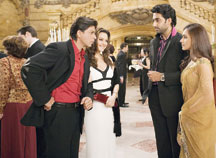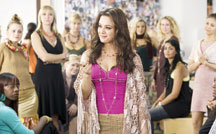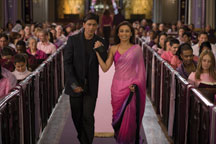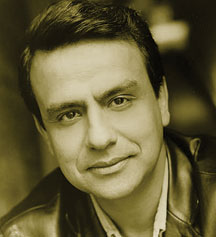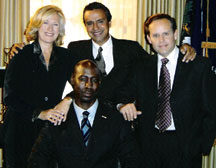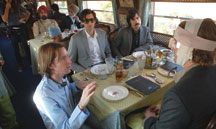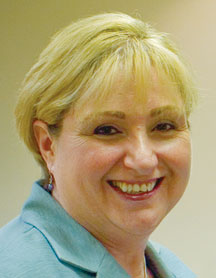Arts
Extra! Extra! Wanted a Bollywood Extra!
Now you too can star in a blockbuster movie
|
Lights, camera, action! You’re on the silver screen……… Admit it – you’ve always dreamt of being up there, rubbing shoulders with Shah Rukh Khan, Preity Zinta, Saif Ali Khan, Rani Mukherjee and the gang, larger than life, on a vast cinemascope screen, surrounded by Dolby Sound. Well, you can still do it – even if life and work have taken you in a different direction. You can do it – even if you can’t act to save your life!
Yes, you can be an extra in a Bollywood or Hollywood movie – take your pick – and it’s never been easier. Instead of going to Bollywood or Hollywood – these megaliths are coming to you! The opportunities are ever increasing as even Hollywood directors scrounge for more ethnic faces to create diverse crowd scenes to accurately reflect America’s changing face. At the same time, Bollywood movie-makers with their successful NRI formula are turning New York and California into outposts of India, and recently several Bollywood movies have been shot in the U.S., and all require some desis in crowd scenes. Think Kal Ho Na Ho, Kabhi Alvida Na Kehna, Jaanema, Ta Ra Rum Pum, and several Dev Anand films including Love in Times Square. Yes, all those desis milling around in those shots in Time Square and other tourist spots were NRIs, just like you.
So what does being an extra require? Stamina certainly, and also patience to sit through hours and hours of retakes. You may not get to have heart-to-heart chats with your heart-throbs, but you will technically be in the same room, breathing the same air! New York independent producer Anadil Hossain’s company Dillwood, Inc., has line produced many films shot in New York and India, including Kal Ho Na Ho, Swades, Kabhi Alvida Na Khena (KANK) and Ta Ra Rum Pum, all which required scored of extras. She also helped with the casting of The Namesake in India and the global casting for Darjeeling Limited. She jokes, “I’m like the India Hollywood-Bollywood Go to Person.” Since KANK was set in New York, the directors didn’t want to fill the screen with South Asian faces, but still needed some background and featured extras from the community. There was also a demand for Indian dancers for the shooting. She says for featured extras, specific auditions were performed to select the most suitable.
Pooja Narang, a dancer and choreographer who runs Bollywood Axion, a dance school in New York is often tapped for her students to participate in dance sequences in Bollywood films, such as Jaaneman and Kabhi Alvida Na Kehna. The term “extra” does have some romantic connotations, evoking scenes of a Hollywood epic like Ben Hur, which had thousands and thousands of extras swarming the sets. But the term is now passé and has been upgraded to the politically correct “background actor.” According to Terri Becherer, director of the Background Actors Department at the Screen Actors Guild (SAG) in Los Angeles, extras are no longer called extras, although the term is common in the industry. SAG contracts for theatrical productions uses the term background actor while contracts for commercials still use the term extra performer. Asked if there were opportunities for South Asians who might want to participate, Becherer said, “Yes, there are a lot of opportunities for people of all ethnic backgrounds. We do have some provisions in our contract that producers accurately portray the American scene, so depending on where the movie takes place – certainly in Los Angeles there’s a very ethnically diverse community out here – and it depends on what the movie is about. Obviously if they are shooting a movie about the 1700’s in Boston, there probably will not be a lot of opportunities for South Asians.”
Extras do not have to be members of the Screen Actors Guild, but a certain number of background actors are covered by SAG on both coasts. For example, on television, SAG covers the first 19 extras on the west coast and in theater 25 on the east coast. She explains, “Let’s say you have a scene with 60 background actors, the first 19 have to be hired under a SAG contract with all the benefits that the union has negotiated – the rest can be paid non-union wages. Becherer walked us through the process of acquiring an assignment: the first step is to go to a casting agency. There are several agencies that specialize in background work in Los Angeles, San Francisco and New York, while casting agencies for commercial work are spread all over the country. Obviously, the most opportunities are in Los Angeles and New York, because these are the centers of filming. But there are other cities with independent film-makers where one could get non-union work. The SAG website (www.sag.org ) publishes the names of scores of casting agencies casting SAG signatory projects. Becherer cautions people to be careful about using casting agencies found on the Internet for casting agencies and to be wary of scams and of agencies that charge exorbitant fees.
Producers look for people appropriate to the scene and time period of the film. Shooting a scene in a park in Southern California, for instance, requires people of all ages and ethnicities in the background. What are they looking for in the extras? People who show up on time and in suitable wardrobes and display a level of professionalism on the movie set, without trying to take photos or hunt for autographs. They also have to be very patient and be prepared for re-takes. “I often get asked what a typical day is for a background actor and there’s no such thing,” she says. “Some days you may be a wedding guest and you’re sitting in an air-conditioned church all day. Then there may be a day you’re out there, running up and down hills. Background actors have to be prepared for inclement weather and stay there as long as you need to, because you’re working under a SAG contract for a minimum of 8 hours.” She points out that in the movie industry not much attention is paid to the clock so if the director wants to keep working, everyone has to stay there and it can become pretty long hours. Working under a SAG contract, extras are paid a minimum of $130 for 8 hours. They get overtime, which is time and a half, for the night shift of 12 hours and double time after that. There are no requirements on the part of the filmmakers to provide meals unless the cast and crew is also being provided meals on location, but most of the time they do.
Those thinking that their brush with fame will entitle them to connect with Brad Pitt or Jennifer Lopez are likely to be disillusioned. Says Becherer, “They may be passing by them or standing very close, but as far as interacting with them when they are not in a working environment, probably not.” Sometimes you may be pulled out of oblivion and given a speaking part (which entails a whole different contract), but that is rare. For extras with bigger dreams, Becherer recommends going a different route – acting classes, treating it just like any other career choice. She adds, “It’s a highly competitive field. There are a lot of people doing this. If this is something you’re truly interested in there are opportunities.” Ajay Mehta knows them well. A resident of Los Angeles, he is one Indian American actor seen frequently in Hollywood movies and television shows. “I have done background work although I didn’t start out as an extra,” he says. He made his U.S. Primetime TV debut in 1989 on NBC’s Around the World in 80 Days in a scene with Sir Peter Ustinov shot in Hong Kong where he was living at the time. He later made his way to New York, was spotted by a casting director who called him in to read for a feature film role, which was ultimately never made. But Mehta got the bug. He has acted in guest and featured roles in many movies and films, such as a Middle Eastern ambassador on 24, a Pakistani general in The E Ring, a neurosurgeon on Eli Stone, as well as in the Sopranos and Eli Stone.
Now a SAG actor, he did background parts just to make some money sometimes and also in the hope of beging upgraded sometime. “If they give you one word to say – ‘hello’ – you’re suddenly a featured actor,” he says. “Bruce Willis started out as an extra and Clint Eastwood was picked out of the crowd when he was a background actor. At one point or the other, many people do it.” Although Mehta himself has enough work now, he recalls doing background work early in his career to meet the minimum work required by SAG to qualify for their pension and health plan. He says, “So for nine years I didn’t have to pay a penny for health insurance. How nice is that?” His advice to aspiring actors is to connect with casting directors who just do background work in New York and California. He suggests picking up the Ross Report, a little booklet that lists casting directors in various cities, and look up ones that do background work. Aspiring actors also need an 8×10 photograph and oodles of commitment. “The thing people have to understand is that there has to be commitment, for the money is not there,” he says. “”You can’t just show up one day and then by the third day you decide that you can’t do it. The continuity has to be there. This is a business and it’s a multimillion dollar industry and people have to be committed.”
He says the demand for extras is considerable. In a television show Mismatch, in which he acted, several Indians were needed for a wedding scene. In the movie The Guru, in which he had a featured role, casting agents recruited several young Indians for a dance sequence in New York. He’s had featured roles from doctors to sheiks and ambassadors in several movies like Ashes and Ocean of Pearls, all of which required South Asian background actors. So you don’t have to be an actor to be an extra? “No, no, not at all,” he says. “They need real people. They’ll dress you or you bring your own outfits. The reason people prefer to bring their own outfits is because they fit better. I had to go for a national commercial and it was a wedding scene again, I had to wear my achkan. I have it; they don’t.” Sometimes, finding specific extras, such as family to play roles of father, mother, child can be hard. Hossain says sometimes she has turned to the Shawn and Rita Powers casting agency in New York, which specializes in background actors. However no one casting agency specializes in a South Asian talent pool. Recalls Hossain, “We had to do cold calls, we had to do a lot of community outreach, going out to Jackson Heights, placing advertisements in ethnic weeklies, for extras.”
“I’ve always thought about this and I’ve always wondered about it,” Hossain says. “Someone could really do well in starting a casting agency that specializes in representing South Asian talent, because it’s a growing demographic. I think we are a growing face and voice of America, we are the fastest growing ethnic minority here. In the future there will be more roles and hopefully, more visible faces in mainstream media.” Almost every film Hossain has worked on, she has needed South Asian faces from featured roles to extras. “For Darjeeling Limited we did this worldwide search for the love interest. The director had a very specific idea of what he wanted and we did a wide search and eventually found this amazing actress in London of all places.” For The Namesake in New York as well as in India, the local Bengali community was tapped for the right faces so casting involved a lot of word of mouth and community outreach.
However, Hossain says an extra’s life is not all rosy, She says, “You know the expectations can be really high, because people feel they can come out and hang out with stars all day and it’s going to be an amazing experience – and often it’s the worst experience. They are called on the set and they may be one face in hundreds in the background with no particular activity or action.” So what does a producer look for in an extra? She is quite frank: “They are really fillers – if you’re doing a football scene (as in KANK) then you look for a football going crowd – you don’t want 60 year old grannies. You have to define the demographic to the scene you have. In a romantic restaurant scene you need a smattering of couples of different age groups as extras in the background.” In a Bollywood movie, dancers are almost mandatory. For a Karan Johar film 20 women between the ages of 18 and 25 – all of a certain height, all brunettes and dressed in the same way – may be required for one of the song and dance scenes. So it can be very generic, or very specific, depending on the director.
Hossain says that extra casting is a fascinating element of any production, because it’s so much a part of the background and audiences have no idea what goes into a scene with thousands of extras, such as a shot at a football game. She says, “The whole day you are having to facilitate that. You need a place to hold them, you need a place to feed them, you need to feed them, you need to make sure they can get to and back from a remote location.” While shooting in Connecticut there was no local talent pool, so they had to bring in our extras from New York. When canvassing for extras, the producers have to be wary of over-enthusiastic fans. “We had these big shaadi scenes in Long Island and we needed a lot of extras for that. Lot of fans showed up to be next to Preity Zinta, so we have to really worry about that and screen that,” she says. “You can’t put in an ad saying be in a scene with Preity Zinta, because then you’d have 50 million people show up! And this is what happened – so many people gate crashed the sets of Kal Ho Na Ho because they heard about it from the grapevine.”
On the other hand, often extras don’t show up after committing, because it’s just a lark for them and something more important turns up, which can be a real problem for the film unit. So producers give a call for 30 extras when they need just 10. Extras get to eat with the crew. If it’s a union film, then extras get the standard rates, but in a a non-union film, the rates can be anything the filmmaker decides – $20 or $100 a day. Says Hossain, “If with SAG you don’t show up, you wouldn’t get hired again, but non-union people sometimes don’t show up at all. The rates aren’t anything that will make you rich and the work is not glamorous either. People often show up expecting one thing and end up getting very disappointed. It’s not for the faint of heart.” Most aspirants for extras have wrong perceptions: they imagine they will get to watch the shooting, but they don’t. They are usually held in another room until needed. They have to be available for the whole day and can’t have any other obligations. They are paid at the end of the day and have to be aware that the day could be long. Only occasionally, says Hossain: “Certain extras become almost like characters on the set. They keep showing up and become part of the crew. You also have to recycle your extras. The extras that are at the back are the front today, the front ones are at the back tomorrow, out of focus. These are the tricks of the trade.” The dreary experience notwithstanding, most extras are still bound to find glamour in being associated with cinema, however peripherally. After all, desis have Bollywood flowing in their blood and they can no more say no to Shah Rukh or Preity or Rani than not breathe. Hossain recalls the nightmare of shooting at the Grand Central concourse with three big stars. She had warned the Grand Central police about security, but they had scoffed: “Yeah, whatever, we’ve had Tom Cruise here. I’m sure we can handle it!” Hundreds of Indians showed up and the shoot could not be conducted. Says Hossain, “All it probably took is one call: “Rani and Shah Rukh are in Grand Central shooting.” We couldn’t technically stop anyone from coming since it was a public space, but it no longer looked like the Grand Central since it was swamped with desis – it ended up looking like Little India!” Bollywood in their veins, with Indians you have to reckon with the problem of extra extras!
|


